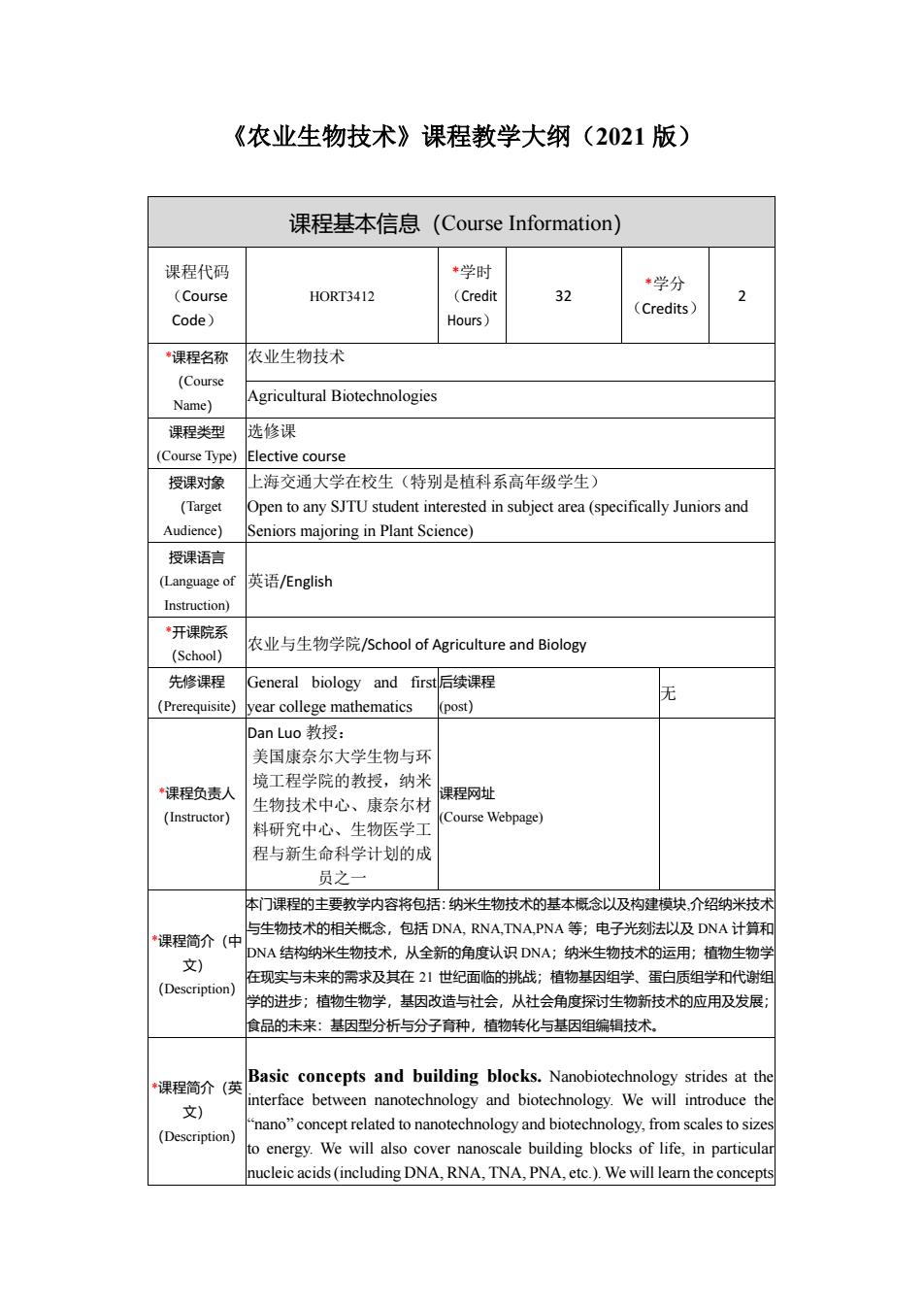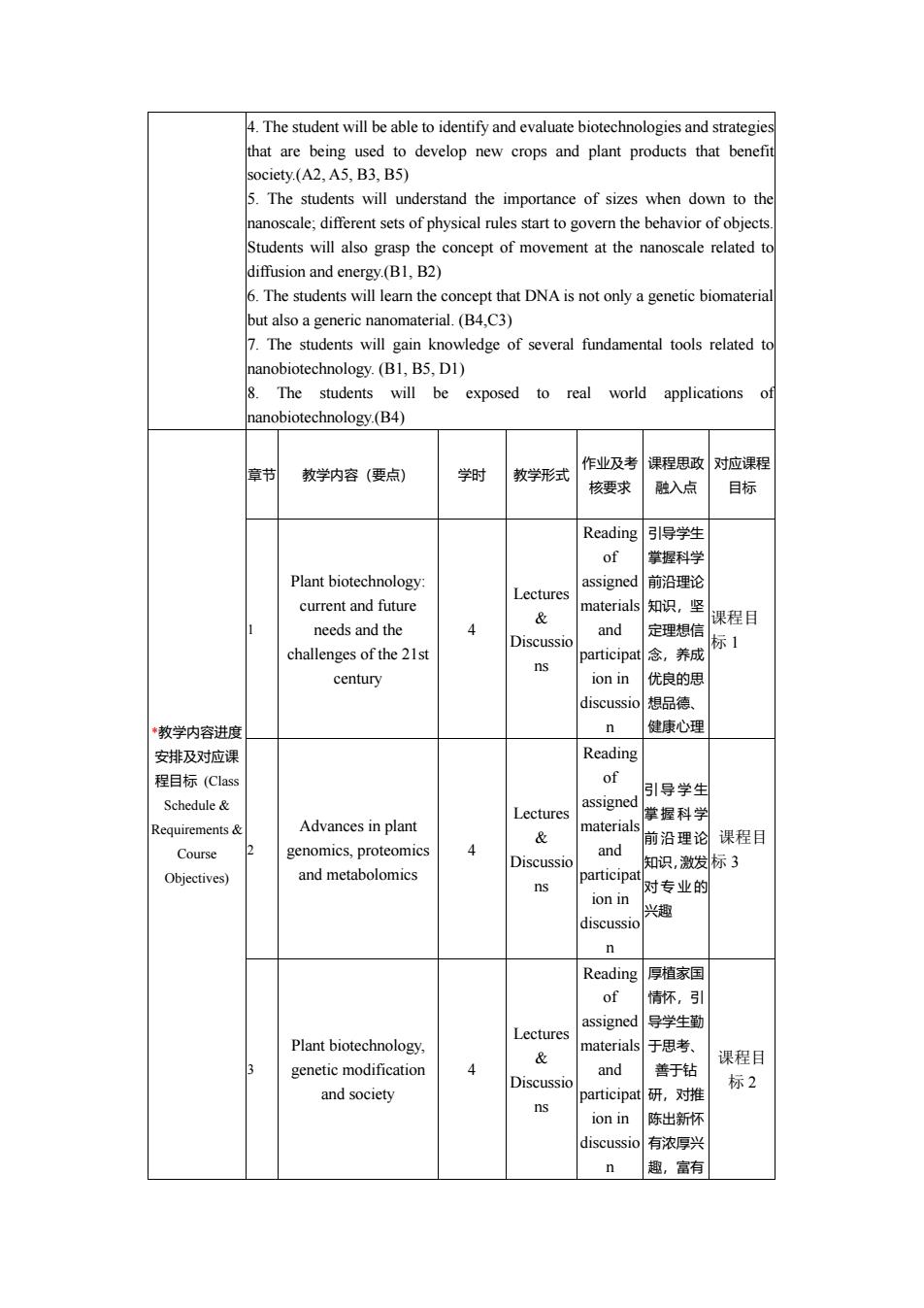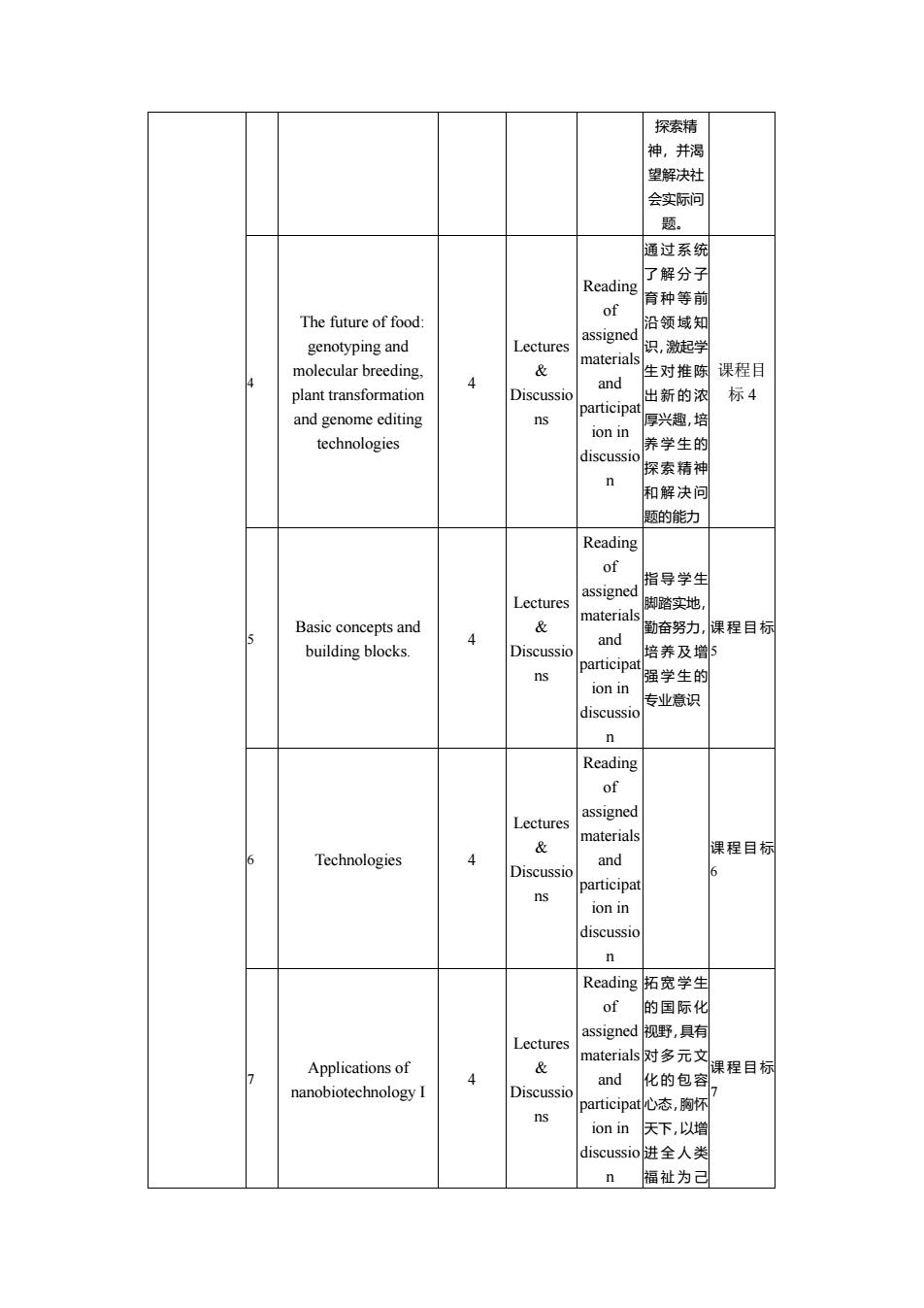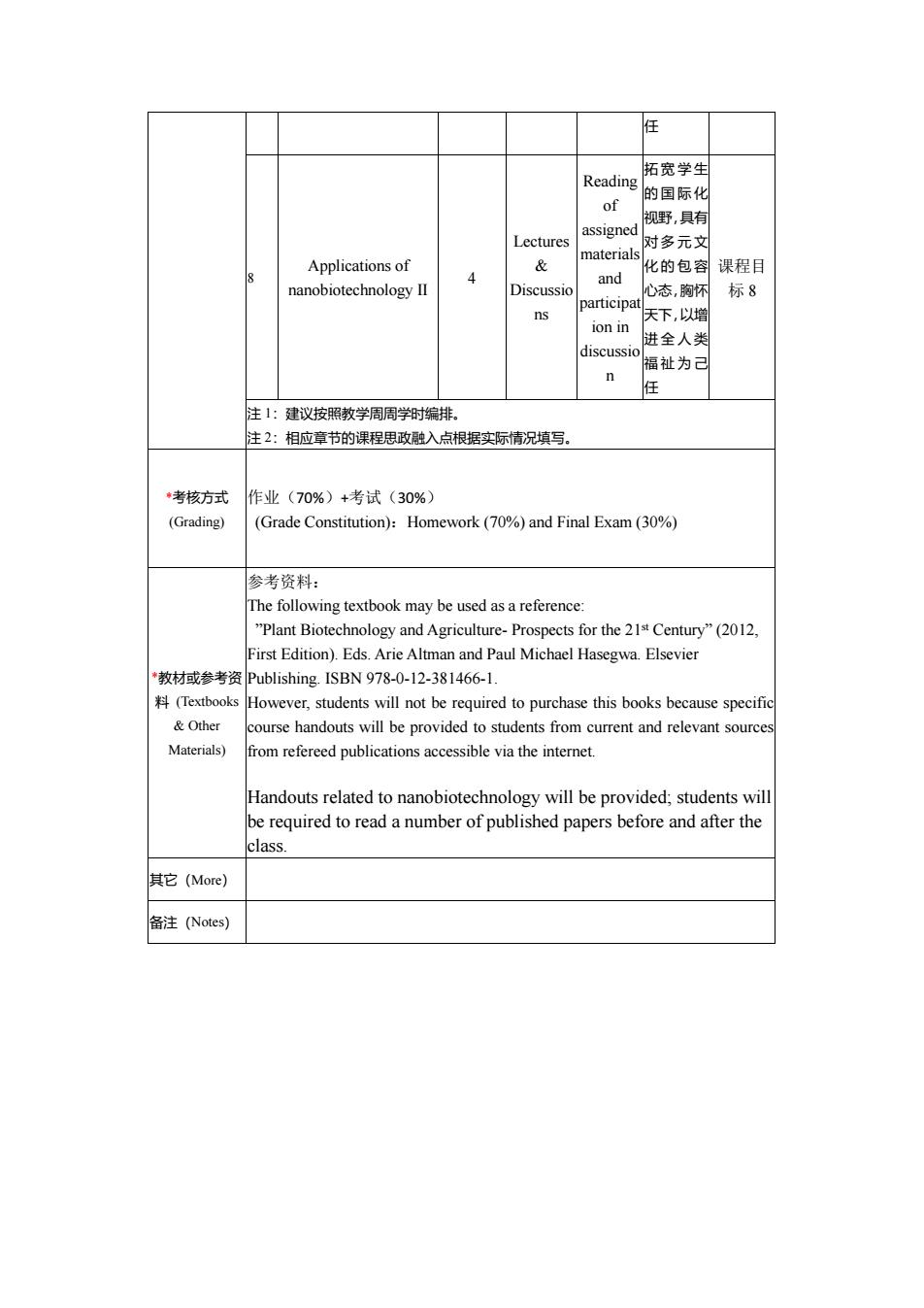
《农业生物技术》课程教学大纲(2021版) 课程基本信息(Course Information) 课程代码 *学时 HORT3412 (Credi 32 ·学分 (Cours (Credits) 2 Code) Hours) 课程名弥 农业生物技术 (Course Name) Agricultural Biotechnologies 课程类型 选修课 (Course Type) Elective course 搭理对炮 上海交通大学在校生(特别是植科系高年级学生) Open toany SJTUstudent interested in subject area ( Audience) eniors majoring in Plant Science) 授课语言 (Language of 英语/Enelish Instruction “开课院系 (School) 农业与生物学院/5 chool of Agriculture and Biology 先修课程 General biology and first后续课程 (Prerequisite ear colle mathematics Dan Luo教授: 美国康奈尔大学生物与环 章工程学院的教授,纳米 理程伤素人 生物持术中心、康尔 课程网址 斜研究中心、 生物医学 urse Webpage) 程与新生命科学计划的成 员之一 本门闺程的要学内容将句括:纳米生物技术的其本据念以及构持快介纽纳米技 *课程简介(中 生物技术的相关 包括DNA RNA,TNA.PNA等:电子光刻法以及DNA计算和 DNA结构纳米生物技术,从全新的角度认识DNA;纳米生物技术的运用:植物生物 文) (Description 在现实与未来的需求及其在21世纪面临的挑战:植物基因组学、蛋白质组学和代谢辉 学的进步;植物生物学,基因改造与社会,从社会角度探讨生物新技术的应用及发展 食品的未来:基因型分析与分子育种,植物转化与慕因组编相技术。 “课程简介(英 Basic concepts and building blocks.Nanobiotechnology strides at the interface between nanotechnology and biotechnology.We will introduce the 文) nano"concept related to nanotechnology and biotechnology.from scales to size (Descrintion) ergy.We will also nanoscale building blocks of life,in particula cleic acids (including DNA.RNA.TNA.PNA,ete.).We will leamn the concepts
《农业生物技术》课程教学大纲(2021 版) 课程基本信息(Course Information) 课程代码 (Course Code) HORT3412 *学时 (Credit Hours) 32 *学分 (Credits) 2 *课程名称 (Course Name) 农业生物技术 Agricultural Biotechnologies 课程类型 (Course Type) 选修课 Elective course 授课对象 (Target Audience) 上海交通大学在校生(特别是植科系高年级学生) Open to any SJTU student interested in subject area (specifically Juniors and Seniors majoring in Plant Science) 授课语言 (Language of Instruction) 英语/English *开课院系 (School) 农业与生物学院/School of Agriculture and Biology 先修课程 (Prerequisite) General biology and first year college mathematics 后续课程 (post) 无 *课程负责人 (Instructor) Dan Luo 教授: 美国康奈尔大学生物与环 境工程学院的教授,纳米 生物技术中心、康奈尔材 料研究中心、生物医学工 程与新生命科学计划的成 员之一 课程网址 (Course Webpage) *课程简介(中 文) (Description) 本门课程的主要教学内容将包括:纳米生物技术的基本概念以及构建模块,介绍纳米技术 与生物技术的相关概念,包括 DNA, RNA,TNA,PNA 等;电子光刻法以及 DNA 计算和 DNA 结构纳米生物技术,从全新的角度认识 DNA;纳米生物技术的运用;植物生物学 在现实与未来的需求及其在 21 世纪面临的挑战;植物基因组学、蛋白质组学和代谢组 学的进步;植物生物学,基因改造与社会,从社会角度探讨生物新技术的应用及发展; 食品的未来:基因型分析与分子育种,植物转化与基因组编辑技术。 *课程简介(英 文) (Description) Basic concepts and building blocks. Nanobiotechnology strides at the interface between nanotechnology and biotechnology. We will introduce the “nano” concept related to nanotechnology and biotechnology, from scales to sizes to energy. We will also cover nanoscale building blocks of life, in particular nucleic acids (including DNA, RNA, TNA, PNA, etc.). We will learn the concepts

of polymers,hierarchy assemblies and self-assemblies. Technol gies Wewill e photolithography ().whic isne ofthe fundamental toos torealinoooy.We will aso ea DNA from an entirely new perspective:as programmable molecules.Examples including DNA computing and DNA structural nanotechnology (e.g,DNA origami) Applications of nanobiotechnology I:DNA as nanoscale organizerst semble nanoparticles and as nanoscale scaffolds for novel biosensing anc diagnosis. Applications of nanobiotechnology II:DNA as both generic and generi nanoscale building blocks for the creation of novel materials. Plant:and future needs and the challenges of thes century.Society is facing growing challenges associated with feedin the rapid expanding global population,while dealing with factors that limit foo production,such as climate instability and loss of agricultural land.We will discuss those challenges and identify issues that will limit future food security. Advances in plant ge omics,proteomics and metabolomics.The ade has seen an explc on in the development of new hnologies to stud living organisms,and particularly those related to the study of their genomes.Thi lecture will provide an overview of cutting edge technologies that are used to study plants,crop production and plant genetic diversity. Plant biotechnology,genetic modification and society.The applicatic of biotech crop production,and particulrly the use netic modification technologies is a politically sensitive issue that can b difficult for the general public to understand.This lecture and discussion sectior will focus on the related issues of new technologies,food,communication and the sensitivities of society to the nature of the food supply. and genome editing techr Feeding a human population that will likely reach 10 billion over the next fev decades will require the development of new types of crops and cropping systems This lecture will examine current technologies that are being used to create nev enerations of crops. 课程目标与内容(Course objectives and contents) 1.The student will be able factors that i limit global crop production over the coming decades.(A4,A5,B4) 2.The student will be able to identify and evaluate 'omics'technologies that are 课程目标 being used to study plant biological processes and diversitv.(B2.B4) (Course Obiect 3.The student will be able to identify and evaluate arguments that are used both for and against the use genetically modified ros and their application enhance food security.(B2.C3.C4)
of polymers, hierarchy assemblies and self-assemblies. Technologies We will learn photolithography (including microfluidics), which is one of the fundamental tools to realize nanotechnology. We will also learn DNA from an entirely new perspective: as programmable molecules. Examples including DNA computing and DNA structural nanotechnology (e.g., DNA origami). Applications of nanobiotechnology I: DNA as nanoscale organizers to assemble nanoparticles and as nanoscale scaffolds for novel biosensing and diagnosis. Applications of nanobiotechnology II: DNA as both generic and generic nanoscale building blocks for the creation of novel materials. Plant biotechnology: current and future needs and the challenges of the 21st century. Society is facing growing challenges associated with feeding the rapidly expanding global population, while dealing with factors that limit food production, such as climate instability and loss of agricultural land. We will discuss those challenges and identify issues that will limit future food security. Advances in plant genomics, proteomics and metabolomics. The last decade has seen an explosion in the development of new technologies to study living organisms, and particularly those related to the study of their genomes. This lecture will provide an overview of cutting edge technologies that are used to study plants, crop production and plant genetic diversity. Plant biotechnology, genetic modification and society. The application of biotechnology to agricultural crop production, and particularly the use of genetic modification technologies is a politically sensitive issue that can be difficult for the general public to understand. This lecture and discussion section will focus on the related issues of new technologies, food, communication and the sensitivities of society to the nature of the food supply. The future of food: genotyping and molecular breeding, plant transformation and genome editing technologies. Feeding a human population that will likely reach 10 billion over the next few decades will require the development of new types of crops and cropping systems. This lecture will examine current technologies that are being used to create new generations of crops. 课程目标与内容(Course objectives and contents) *课程目标 (Course Object) 1. The student will be able to identify, evaluate and discuss major factors that will limit global crop production over the coming decades.(A4, A5, B4) 2. The student will be able to identify and evaluate ‘omics’ technologies that are being used to study plant biological processes and diversity.(B2, B4) 3. The student will be able to identify and evaluate arguments that are used both for and against the use of genetically modified crops and their application to enhance food security.(B2,C3,C4)

4.The student will be able to identify and evaluate biotechnologies and strategies used to develop new crops and plant products that benef 5.The students will understand the importance of sizes when down to the nanoscale,different sets of physical rules start to govern the behavior of objects Students will also grasp the concept of movement at the nanoscale related to diffusion and energy.(B1.B2) but also a generic nanomaterial.(B4,C3) 7.The students will gain knowledge of several fundamental tools related to nanobiotechnology.(B1,B5,D1) 8.The students will be exposed to real world applications iotechnology.(B4) 救学内容(要点) 学时 作业及考 课程思政对应课 教学形式 核要求融入点目标 Reading写引导学生 of掌握科学 Plant biotechnology Lectures assigned前沿理论 naterials知识,坚 needs and the 4 and 定理想信 课程目 Discussic challenges of the 21st ns participat念,养成际l century ionin优良的思 discussio想品德, *教学内容进店 健康心理 安排及对应调 Reading 程目标(C1as3 of 引导学生 Lectures 掌握科学 Requirements Advances in plant g material Course genomics,proteomic 4 and Objectives) and metabolomics participa ns 对专业的 ion in discussio n Reading厚植家国 of 情杯,引 assigned导学生勤 Plant biotechnology Lectures materials于思考、 genetic modification & and 课程目 善干钻 Dis and society ns 对推 标2 ion in 陈出新怀 discussio有浓厚兴 n 趣,富有
4. The student will be able to identify and evaluate biotechnologies and strategies that are being used to develop new crops and plant products that benefit society.(A2, A5, B3, B5) 5. The students will understand the importance of sizes when down to the nanoscale; different sets of physical rules start to govern the behavior of objects. Students will also grasp the concept of movement at the nanoscale related to diffusion and energy.(B1, B2) 6. The students will learn the concept that DNA is not only a genetic biomaterial but also a generic nanomaterial. (B4,C3) 7. The students will gain knowledge of several fundamental tools related to nanobiotechnology. (B1, B5, D1) 8. The students will be exposed to real world applications of nanobiotechnology.(B4) *教学内容进度 安排及对应课 程目标 (Class Schedule & Requirements & Course Objectives) 章节 教学内容(要点) 学时 教学形式 作业及考 核要求 课程思政 融入点 对应课程 目标 1 Plant biotechnology: current and future needs and the challenges of the 21st century 4 Lectures & Discussio ns Reading of assigned materials and participat ion in discussio n 引导学生 掌握科学 前沿理论 知识,坚 定理想信 念,养成 优良的思 想品德、 健康心理 课程目 标 1 2 Advances in plant genomics, proteomics and metabolomics 4 Lectures & Discussio ns Reading of assigned materials and participat ion in discussio n 引导学生 掌握科学 前沿理论 知识,激发 对专业的 兴趣 课程目 标 3 3 Plant biotechnology, genetic modification and society 4 Lectures & Discussio ns Reading of assigned materials and participat ion in discussio n 厚植家国 情怀,引 导学生勤 于思考、 善于钻 研,对推 陈出新怀 有浓厚兴 趣,富有 课程目 标 2

探索 望解决社 会实际问 题 通过系纳 了解分 Reading of 育种等前 The future of food 沿领域知 assigned genotyping and Lectures 识,激起学 molecuar breeding & 生对推裤课程目 plant transformatior Discuss 出新的浓 标4 participa and genome editing ns ion in 厚兴培 technologies discussic 养学生的 探素精神 和解决问 题的能力 Reading of 指导学生 脚*克地 Basic concepts and 4 & 勤奋努力,课程目标 building blocks Discuss participa 培养及增 ns 强学生的 ion in discussio 专业意识 Reading of assigned Lectures material Technologies & and 课程目标 participa ns ion in discussio n Reading炻宽学生 of 的国际化 Lectures assigned视野,具有 materials对多元文 Applications of & 课程目标 and化的包容 Discussio participat心态,陶怀 ns ionn天下,以 discussio进全人类 n福祉为己
探索精 神,并渴 望解决社 会实际问 题。 4 The future of food: genotyping and molecular breeding, plant transformation and genome editing technologies 4 Lectures & Discussio ns Reading of assigned materials and participat ion in discussio n 通过系统 了解分子 育种等前 沿领域知 识,激起学 生对推陈 出新的浓 厚兴趣,培 养学生的 探索精神 和解决问 题的能力 课程目 标 4 5 Basic concepts and building blocks. 4 Lectures & Discussio ns Reading of assigned materials and participat ion in discussio n 指导学生 脚踏实地, 勤奋努力, 培养及增 强学生的 专业意识 课程目标 5 6 Technologies 4 Lectures & Discussio ns Reading of assigned materials and participat ion in discussio n 课程目标 6 7 Applications of nanobiotechnology I 4 Lectures & Discussio ns Reading of assigned materials and participat ion in discussio n 拓宽学生 的国际化 视野,具有 对多元文 化的包容 心态,胸怀 天下,以增 进全人类 福祉为己 课程目标 7

食 拓窟学生 的国际化 of 视野,具有 assigne materia 对多元文 Applications of & and 化的包容课程目 nanobiotechnology II Discussic 心态,胸怀标8 天下以增 ion in discuss 进全人类 n 福祉为己 任 注1:建议按照教学周周学时绵排。 注2:相应章节的课程思政融入点根据实际情况填写。 “考核方式 作业(70%)+考试(30%) (Grading) (Grade Constitution):Homework(70%)and Final Exam (30%) 参老资料: wing may be used "Plant Biotechnology and Agriculture-Prospects for the 2Century"(2012 First Edition).Eds.Arie Altman and Paul Michael Hasegwa.Elsevier "救材域参考资Publishing.ISBN978-0-12-381466-l. (Textbooks However,students will not be required to purchase this books because specific &Other urse handouts will be provided to stude from curent and relevant sour om refereed publications accessible via the internet. Handouts related to nanobiotechnology will be provided,students wil be required to read a number of published papers before and after the class 其它(More) 备注(Notes)
任 8 Applications of nanobiotechnology II 4 Lectures & Discussio ns Reading of assigned materials and participat ion in discussio n 拓宽学生 的国际化 视野,具有 对多元文 化的包容 心态,胸怀 天下,以增 进全人类 福祉为己 任 课程目 标 8 注 1:建议按照教学周周学时编排。 注 2:相应章节的课程思政融入点根据实际情况填写。 *考核方式 (Grading) 作业(70%)+考试(30%) (Grade Constitution):Homework (70%) and Final Exam (30%) *教材或参考资 料 (Textbooks & Other Materials) 参考资料: The following textbook may be used as a reference: ”Plant Biotechnology and Agriculture- Prospects for the 21st Century” (2012, First Edition). Eds. Arie Altman and Paul Michael Hasegwa. Elsevier Publishing. ISBN 978-0-12-381466-1. However, students will not be required to purchase this books because specific course handouts will be provided to students from current and relevant sources from refereed publications accessible via the internet. Handouts related to nanobiotechnology will be provided; students will be required to read a number of published papers before and after the class. 其它(More) 备注(Notes)

备注说明 1.带内容为必填项。 2.课程简介字数为300-500字;课程大纲以表述清楚教学安排为宜,字数不限
备注说明: 1.带*内容为必填项。 2.课程简介字数为 300-500 字;课程大纲以表述清楚教学安排为宜,字数不限